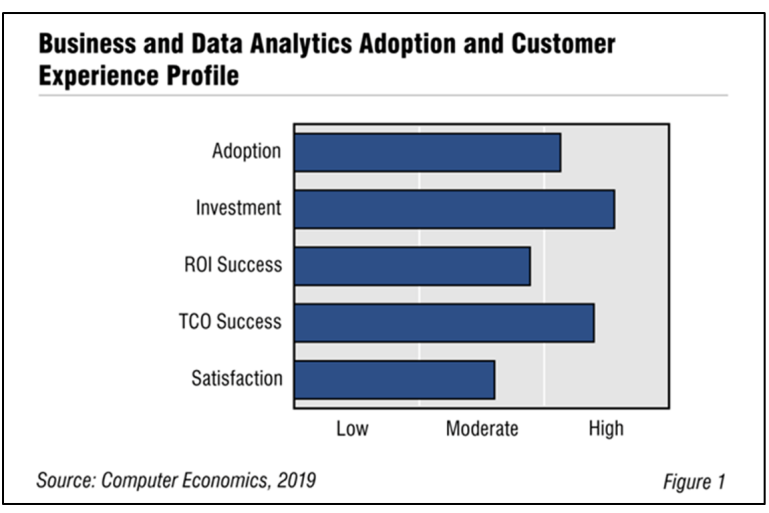IT organizations continue to devour data at unprecedented rates as both adoption and investment in business and data analytics are reaching new highs. In recent years, business and data analytics systems have moved from strategic to operational applications, sometimes extracting data directly from transactional systems such as ERP, CRM, and other operational systems.
As shown in Figure 1 from our full report, Business and Data Analytics Adoption Trends and Customer Experience, the adoption rate, investment rate, and TCO success rate for business and data analytics are all high, compared with other technologies in our Technology Trends study.

Business and data analytics refer to a broad range of tools to collect, store, integrate, analyze, and present information that supports decision-making. Our definition of this technology includes data warehouses, data marts, business intelligence, predictive analytics, data mining, dashboards, online analytical processing (OLAP), end-user report writers, and big data.
Typical applications of business and data analytics systems help top managers identify spending trends, detect fraud, and lower the cost of marketing campaigns. They also can be used to alert customer service representatives to upsell opportunities, among many other applications.
Real-time business analytics represents a newer class of tools designed to unearth the relationships among a range of data, use their own repositories, and often present themselves as easy, flexible tools with sophisticated graphical-presentation capabilities and responsive in-memory processing. One issue (or benefit, depending on one’s point of view) with these solutions is that line-of-business users can bypass the central IT organization and create their own departmental solutions. Vendors in this area include Tableau Software (which Salesforce is buying), Tibco Software, Qlik, and others.
In addition to those capabilities, analytics is driving new products by combing real-time data with machine learning and artificial intelligence. Companies can now develop insights into machinery failures or potential disruptions in supply chains. The impact will only grow, as analytics evolves from a technology that mainly looks backwards at past performance to one that becomes more predictive.
It’s not all sunshine and roses, however. There are some headwinds in the business and data analytics world.
“Given the high investment rates, strong total cost of ownership numbers, and fairly strong ROI, it is somewhat surprising to see that satisfaction is only moderate,” said Tom Dunlap, director of research for Computer Economics, an IT analyst firm based in Irvine, Calif. “Analytics can be complicated, and it requires serious commitment and specialized skills. Analytics is also a never-ending project with no completion date, unlike the launch of a new application. These factors can combine to create a sense that analytics is a bottomless pit. It is important with any analytics project to chart goals and progress in order to bring focus to the project.”
Our full report examines adoption trends for business and data analytics technology of all types, providing insight into how many organizations have the technology in place, how many are implementing it, and how many are expanding investments in new capabilities. We also recommend steps for a successful implementation.
This Research Byte is based on our report on this subject, Business and Data Analytics Adoption Trends and Customer Experience. The full report is available at no charge for Avasant Research subscribers, or it may be purchased by non-subscribers directly from our website (click for pricing).

